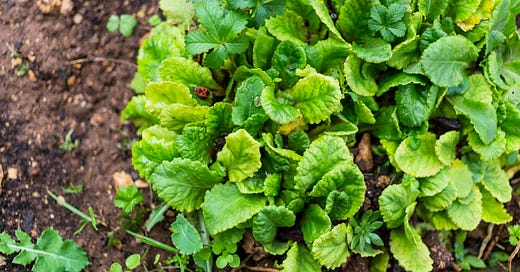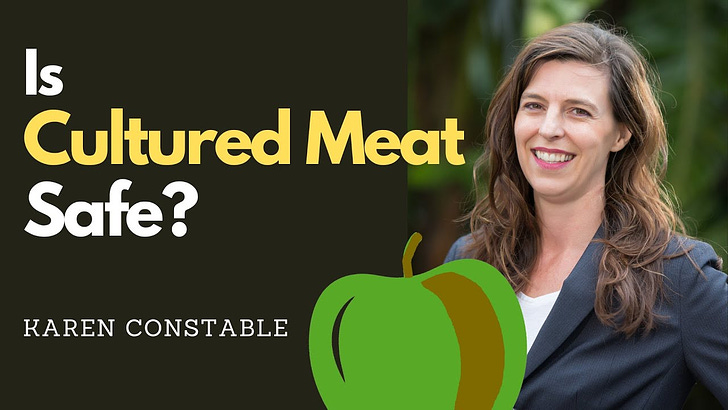136 | E. coli in leafy greens | What do fire hydrants and cookies have in common? | Salmonella in Salmon |
Save time and catch up while you are on the go with our podcast
Save time by listening, now on your favourite podcast app;
E. coli in leafy greens, new knowledge;
Salmonella in salmon;
Food Safety News and Resources;
On fire extinguishers and cookies, fries and breast implants (just for fun);
Food fraud news, emerging issues and recent incidents
Hello,
Welcome to another issue of The Rotten Apple. An extra special huge welcome to the hundreds of new subscribers who signed up last week, I’m thrilled to have you here in our community of food safety champions.
This week’s issue features an overview of Salmonella in salmon and new knowledge about E. coli in leafy greens – classic food safety nerdism! On a more modern (but still nerdy) note, I’ve also included a link to a compilation of my commentary on the food safety aspects of cultured meat.
Our food safety news roundup includes developing news on a recall in the United Kingdom which is now linked to an “active police investigation” due to alleged product tampering. Intriguing! I’ll be following that story with interest, although it could be a while before any details of the investigation are released by the authorities.
As always, this week’s issue finishes with a collection of food fraud updates for paying subscribers. This week’s food fraud news includes an excellent on-demand presentation about overcoming the analytical challenges of detecting genetically modified materials in foods. Plus, the scary-sounding food chemicals that have Instagram influencers freaking out.
Have a wonderful week,
Karen
P.S. Got a burning food safety question you need answered? Or an interesting bit of news to share? Reply to this email, or write to me at therottenapple@substack.com and let me know. I read every response.
Cover image: Freepik
Announcement: Save time with a podcast version of this newsletter
My mission is to save you time while keeping you up to date on the most interesting and relevant food safety and food fraud news from around the globe. Now you can catch up while on the go even more easily, by listening to each issue in your favourite podcast app.
We launched a free public podcast version of this newsletter a few months ago. Each episode is a simple audio version of the open-access parts of the week’s issue, read by me, dodgy Aussie accent and all.
The podcast is available on all major podcast players, including Apple Play and Spotify. Simply search for “The Rotten Apple Food Safety” to find it. Or listen in your browser by clicking the 🎧 Listen 🎧 link at the top of each email.
Here’s a link to last week’s issue (click to listen and save in Spotify):
E. coli in leafy greens: new knowledge
In Issue 53 we explored the root causes of two outbreaks caused by pathogenic Escherichia coli in Romaine lettuce and discovered what can be done to prevent future outbreaks.
Now researchers have shared new knowledge about the survival and growth of E. coli on different types of leafy greens including lettuce.
Why is lettuce linked to more outbreaks than other leafy greens? It’s perhaps because we eat more lettuce than other leafy greens, and absolutely because we almost always eat lettuce raw. But new research shows that lettuce also has different attributes when it comes to the survival and growth of pathogens like Escherichia coli O157:H7 compared to other leafy greens.

Lettuce has different leaf characteristics than waxy-leafed vegetables like kale and collard, when it comes to both roughness and ‘moistness’. For example, kale and collard leaves have a fine coating of wax which lettuce leaves lack. The roughness and waxiness of leaves affect how pathogens like E. coli attach and remain alive on food plants. Storage temperatures after harvest also influence the survival of pathogens on leafy greens.
To investigate these issues, researchers inoculated the leaves of leafy vegetables with E. coli O157:H7 and stored them at different temperatures to see what would happen. They used five types of leafy vegetables: baby spinach, romaine lettuce, green leaf lettuce, collard, and kale, and three storage temperatures: refrigerator temperature (4° C), room temperature (20° C) and body temperature (37° C ), which is the temperature most favoured by E. coli for maximum growth.
Reminder: Not all E. coli is pathogenic. Non-pathogenic strains of the species are found in healthy humans as part of natural, healthy gut microflora. E. coli O157:H7 is a pathogenic strain of E coli. It makes people sick when they consume it in food. Once it is in the intestines, it multiplies and produces toxins which cause symptoms that include bloody diarrhoea, hemorrhagic colitis (HC) and hemolytic uremic syndrome (HUS). E. coli O157:H7 lives harmlessly in the guts of healthy cattle. It gets onto plants from contaminated dust or water. High-intensity animal-raising operations have been implicated as sources of E. coli O157:H7 contamination in foodborne illness outbreaks in North America.
During their inoculation experiments, the researchers discovered that the survival of E. coli was quite different on lettuce compared to waxy greens. The leaves of waxy greens allow E. coli to survive well on the surfaces of the leaves in the refrigerator. Lettuce leaves, on the other hand, don’t allow E. coli to survive when in the fridge, where the bacteria quickly die off.
In warm conditions, the situation is reversed. E. coli can reproduce quickly on lettuce, which has moist leaves, whereas the drier, harder surfaces of waxy greens do not allow for rapid growth, even in warm conditions.
Rapidly refrigerating lettuce after harvest and keeping it cool during subsequent handling and retailing could reduce the risks posed by pathogenic E. coli on lettuce.
In short: 🍏 E. coli multiplies and survives in different ways on different types of leafy greens 🍏 Lettuce, with its moist leaves, allows E. coli to grow rapidly on its surface at warm temperatures but does not support its survival in the refrigerator 🍏 Waxy-leaved vegetables, including kale and collard, are less able to support the growth of E. coli on their surfaces, but their drier leaves allow any E. coli that is present to persist on their leaves during refrigerated storage 🍏
Source:
Dong, M., Holle, M.J., Miller, M.J., Banerjee, P. and Feng, H. (2024). Fates of attached E. coli O157:H7 on intact leaf surfaces revealed leafy green susceptibility. Food Microbiology, [online] 119, p.104432. doi: https://doi.org/10.1016/j.fm.2023.104432.
Read more:
🍏 How Does E.coli Cause Leafy Greens Outbreaks?
🍏 How much did the E. coli Romaine lettuce 2018 outbreak cost?
Salmonella in Salmon
We’ve been talking a lot about Salmonella in fresh produce, chocolate, peanut butter and other (perhaps) unexpected foods lately. Today I want to talk about Salmonella in the food that gave this famous foodborne pathogen its name: salmon.
Raw salmon is a popular ingredient in many dishes, including gravlax, sushi, sashimi and poke bowls. However, raw salmon can also be contaminated with microorganisms, parasites and chemical residues that can cause foodborne illnesses.
In 2022, an outbreak from Salmonella litchfield in fresh, raw salmon supplied to restaurants in the United States sickened 39 people. Salmonella that matched the strain in samples from victims was found in the processing environment at the fish supplier’s facility. The sick people reported eating sushi, sashimi or poke made with raw salmon (source).
Salmonella is a hazard in raw salmon. It gets into the fish from the water it was raised in, its feed or from the processing environment after harvest. Other microbial hazards in raw salmon include Listeria, which can get into salmon during handling and processing as well as parasites, such as worms or flukes.
Chemical hazards, including environmental chemicals and aquaculture drugs, also occur in salmon, with aquaculture drug hazards limited to aquaculture-raised fish and their roe. Environmental chemical hazards are found in both farmed and wild-caught freshwater salmon, but not in wild-caught ocean salmon according to the US FDA.
The good news is that, unlike other species of fish, including certain tropical fish and tuna, salmon is not susceptible to natural marine toxin hazards such as ciguatera. Nor is it affected by scombrotoxin (histamine)-related hazards (source).
Control measures for Salmonella in salmon include pre-harvest monitoring and management of water quality, feed and the harvest environment, as well as vaccination and treatment of fish.
Post-harvest controls of hazards include following good hygiene and sanitation practices during processing, handling, and storage of raw salmon. Direct controls include washing and the freezing of raw salmon to eliminate parasites.
In short: 🍏 Salmonella is a microbial hazard in salmon, and caused an outbreak which sickened people who had eaten raw salmon dishes such as sashimi and poke in 2022 🍏 Other microbial hazards include Listeria and parasites 🍏 Pre-harvest and post-harvest controls must be implemented to reduce the risk of salmonellosis for consumers of raw salmon products 🍏
Further Reading
Possible food safety hazards of ready-to-eat raw fish containing product (sushi, sashimi) - research paper
(US) FDA Fish and Fishery Products Hazards and Controls (2022)
Chapter 4: Pathogens from the harvest area (and controls) - US FDA
Chapter 5: Parasites hazards (and controls) - US FDA
Chapter 9: Environmental chemical contaminants including pesticides (and controls) - US FDA
Chapter 11: Aquaculture drugs (and controls) - US FDA
More from The Rotten Apple
The History of Sushi by Sam O’Nella (Just for Fun) – Issue 91
How Does Salmonella Get Into Seafood? - Issue 91
Food Safety Aspects of Cultured Meat
Last month the Australian cultured meat company Vow launched quail parfait in Singapore, where cultured poultry meat has regulatory approval.
Why quail parfait? It’s a ‘luxury’ meat that can justify the high prices needed for cultured meat right now. And the parfait is said to have a lovely silky texture. To me it makes sense that Vow are not trying to replicate whole meat cuts exactly, but are using their technology to make something unique and ‘luxe’.
Their launch inspired me to make a compilation of past posts about cultured meat safety. Click the link below to read it.
Cultured Meat Safety
What do food safety experts think about the safety of cultured meat? Is it safe?
Food Safety News and Resources
Our food safety news and resources roundups are always free and never boring.
This week’s most unusual news: allegations of deliberate tampering in a metal contamination recall.
Click the preview box below to access it.
Food Safety News and Resources | April
29th April | Food Safety News and Free Resources | Recall: Tortillas tampered with and containing “metal” (UK) | Farmed fish and parasites - new data | SQF Edition 10 drafting has started | Tool: Risk Ranger, a simple Excel-based spreadsheet for Calculating Food Safety Risk (FAO) |
What do fire extinguishers and breast implants have in common with cookies and fries? (Just for fun)
There are posts on social media titled “You won’t believe where silly putty is hiding in your food”. Okayyyy. Time for a reality check! Baking soda, dimethylpolysiloxane and food scare bloggers feature in this de-bunking, pro-food-science video by Food Science Babe.
Below for paying subscribers: Food fraud news and incident reports
📌 Food Fraud News 📌
In this week’s food fraud news:
📌 Emerging risks: Table grapes;
📌 Methods: sake authentication, moringa, honey;
📌 Analytical strategies for GMO and NGT detections;
📌 Fraud in Easter chocolates, smuggled pears, fake sugar, dodgy coffee and more.





